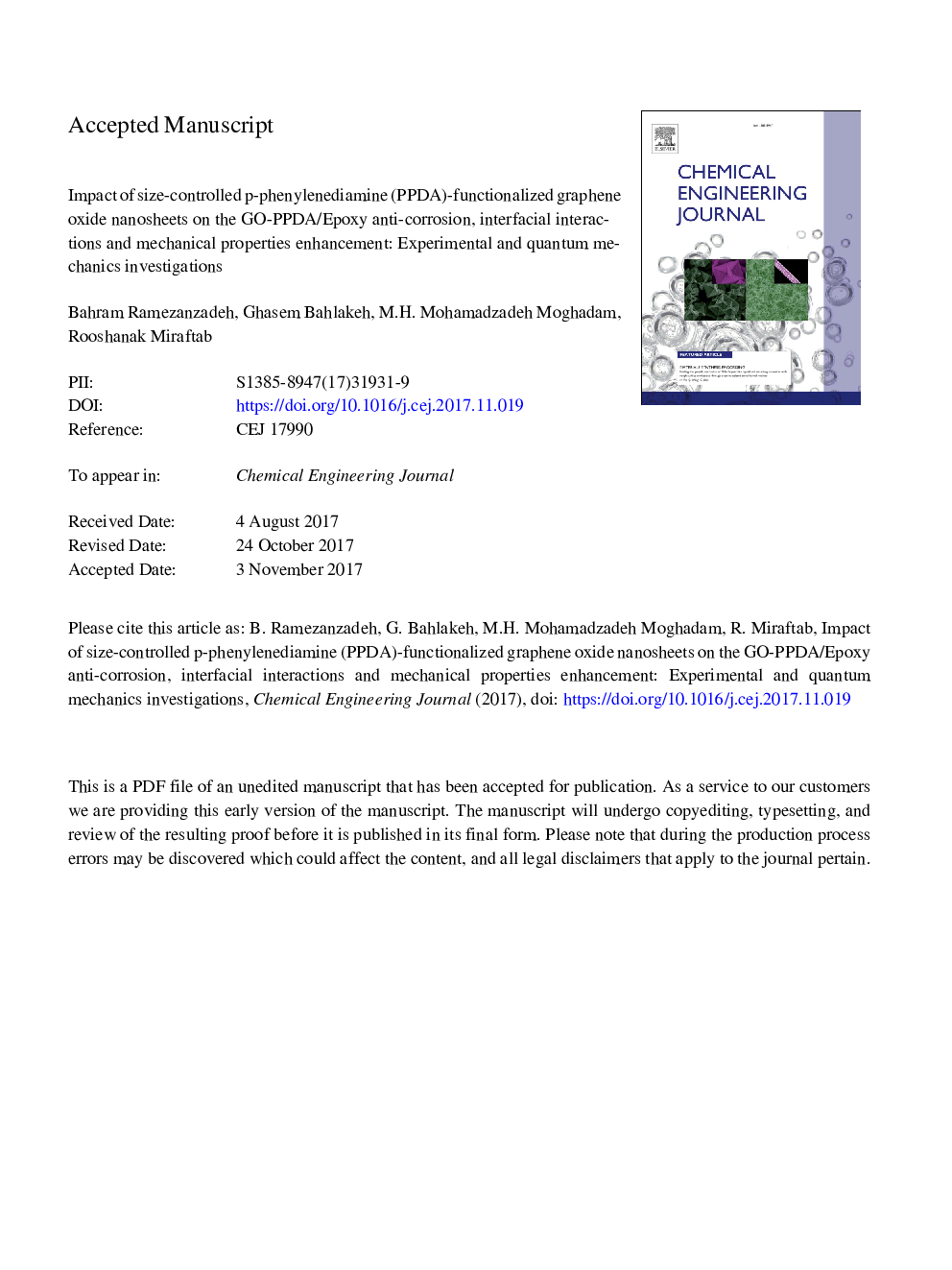| کد مقاله | کد نشریه | سال انتشار | مقاله انگلیسی | نسخه تمام متن |
|---|---|---|---|---|
| 6581034 | 1422943 | 2018 | 50 صفحه PDF | دانلود رایگان |
عنوان انگلیسی مقاله ISI
Impact of size-controlled p-phenylenediamine (PPDA)-functionalized graphene oxide nanosheets on the GO-PPDA/Epoxy anti-corrosion, interfacial interactions and mechanical properties enhancement: Experimental and quantum mechanics investigations
دانلود مقاله + سفارش ترجمه
دانلود مقاله ISI انگلیسی
رایگان برای ایرانیان
کلمات کلیدی
موضوعات مرتبط
مهندسی و علوم پایه
مهندسی شیمی
مهندسی شیمی (عمومی)
پیش نمایش صفحه اول مقاله

چکیده انگلیسی
In this study, the graphene oxide nanosheets (GONs) with three lateral sizes (small area GO (SAGO):0.85â¯Î¼m, medium area GO (MAGO):8.2â¯Î¼m and large area GO (LAGO): 38â¯Î¼m) were synthesized through modified Hummer's method, covalently functionalized by p-phenylenediamine (PPDA), introduced into a polyamine cured epoxy composite and characterized by experimental and theoretical approaches. The GONs size distribution was investigated by a scanning electron microscopy (SEM). The GONs-PPDA nanosheets were characterized by X-ray diffraction (XRD), Fourier transform infrared spectroscopy (FT-IR) and thermal gravimetric analysis (TGA). The GONs-PPDA/epoxy composites were characterized by dynamic mechanical thermal analysis (DMTA), tensile test and electrochemical impedance spectroscopy. The fracture surface morphology and GONs-PPDA distribution in the epoxy matrix were studied by field emission-scanning electron microscopy (FE-SEM). Results revealed that incorporation of the GONs with lateral particle size less than 1000â¯nm into the epoxy matrix greatly improved the mechanical properties of the epoxy matrix. In addition, the anti-corrosion properties of the polymer composite was significantly improved after incorporation of medium sized GO-PPDA sheets, implying that the size control of GONs is an effective approach for obtaining a high performance epoxy composite with enhanced mechanical properties. The theoretical quantum mechanics (QM) results evidenced that diamine/epoxy affinity is due to their H-bonding interactions, and diamine bonding to the GO surface occurred via physical (i.e., H-bonding) and chemical (i.e., proton transfer) interactions. The QM computations also proved that increasing the number of diamine molecules bonded to the GO surface resulted in stronger epoxy binding to the GO surface, an observation further evidencing the improved physical and mechanical properties of epoxy composite filled by diamine-functionalized small-size GO nanosheets found in experiments.
ناشر
Database: Elsevier - ScienceDirect (ساینس دایرکت)
Journal: Chemical Engineering Journal - Volume 335, 1 March 2018, Pages 737-755
Journal: Chemical Engineering Journal - Volume 335, 1 March 2018, Pages 737-755
نویسندگان
Bahram Ramezanzadeh, Ghasem Bahlakeh, M.H. Mohamadzadeh Moghadam, Rooshanak Miraftab,